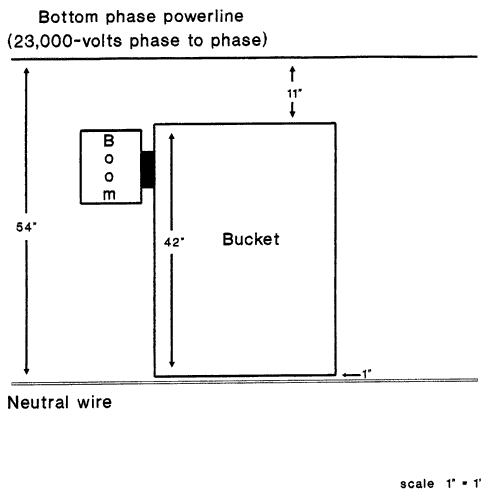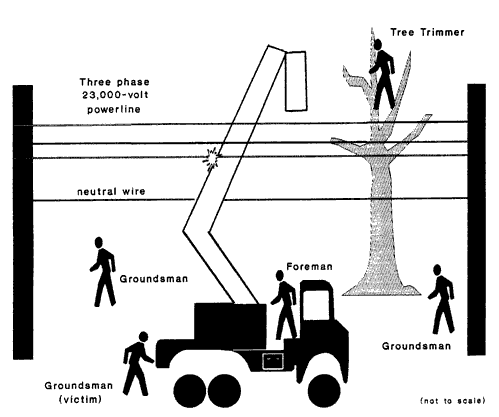Tree Trimming Groundsman Electrocuted after Contacting an Energized Aerial Bucket Truck in South Carolina
FACE 91-03
SUMMARY
A 27-year-old male tree trimming groundsman (victim) was electrocuted while contacting an aerial bucket truck that became energized. The victim was part of a five-man crew assigned to clear brush and trees from an electric utility right-of-way. The tree trimmer, while inside the bucket, extended the boom/bucket between the bottom energized phase of a 23,000-volt, 3-phase powerline and a lower neutral conductor to a tree located about 15 feet on the opposite side of the powerline. The tree trimmer climbed out of the bucket into the tree to proceed with the tree trimming operation. The foreman climbed onto the aerial bucket truck to retract the boom/bucket using the controls mounted on the boom pedestal. During boom repositioning, boom contact with the powerline allowed electrical current to flow through the uninsulated boom and truck to the ground. The victim, who was standing on the ground in contact with the aerial bucket truck, was electrocuted. NIOSH investigators concluded that in order to prevent future similar occurrences employers and utility companies should:
- conduct a pre-work survey at jobsites to identify potential hazards, implement appropriate control measures, and provide subsequent training to employees that specifically addresses all identified site hazards
- ensure that line-clearance tree trimmers maintain the minimum working distances from energized conductors established in current OSHA regulations and ANSI standards
- ensure that aerial bucket truck operators are trained in the safe operation of these vehicles
- contact the local utility company to de-energize or insulate the powerlines when circumstances require operating a aerial bucket truck (or other boomed vehicle) in close proximity to a powerline
- comply with applicable OSHA standards regarding the marking of controls
- review and revise, where applicable, written safety rules and procedures that address working in close proximity to energized overhead powerlines.
INTRODUCTION
On October 23, 1990, a 27-year-old male tree trimming groundsman was electrocuted while touching an aerial bucket truck that became energized. On October 30, 1990, officials of the South Carolina Occupational Safety and Health Administration notified the Division of Safety Research (DSR) of this fatality, and requested technical assistance. On November 6, 1990, two safety specialists from DSR conducted an investigation of this incident. The investigators reviewed the incident with one of the company owners and the OSHA compliance officer assigned to the case. Photographs and diagrams of the incident site and equipment, the medical examiner's report, and the police report were also obtained during the investigation.
The employer in this incident is a tree service company that has been in operation for 42 years and employs 62 workers, including 28 groundsmen. The company has written safety rules and procedures which are administered by the safety officer/company owners and jobsite foremen. Weekly safety meetings are held and documented. The victim worked for this employer for 5 months before this incident.
INVESTIGATION
The company had been contracted by the local electric utility company to clear brush and trees from a powerline right-of-way in a rural part of the state. Work had been in progress for about 3 months prior to this incident, and had been proceeding normally.
On the day of the incident, a five-man crew consisting of a jobsite foreman, one tree trimmer/bucket operator, and three groundsmen, arrived at the jobsite. The three groundsmen, including the victim, were assigned to cut and clear brush from beneath the powerlines at ground level. The tree trimmer/bucket operator was working from the bucket of the aerial bucket truck clearing tree limbs away from the powerline. The foreman was supervising the operation.
About 15 to 20 minutes before the incident, one of the company owners arrived at the worksite to observe the crew's progress and conduct a safety inspection. At that time, the tree trimmer had completed trimming tree limbs near the powerline and was bringing the boom/bucket back to the "landed" position over the cab of the truck. After retrieving his tree climbing gear, the tree trimmer re-entered the bucket and maneuvered the boom/bucket between the neutral wire and the bottom phase of a 23,000-volt, 3-phase powerline.1 The boom/bucket was extended through the powerline about 15 feet and the operator climbed out onto a tree. At this time, the foreman climbed onto the aerial bucket truck to retract the boom using controls mounted on the boom pedestal.2 The boom was inadvertently raised while still positioned between the neutral wire and bottom phase of the powerline (Figure 2). This action brought the boom into contact with the powerline and allowed current to flow through the uninsulated boom and truck to the ground. The victim, who was standing on the ground in contact with the bucket truck, provided an alternate path to ground for the electrical current. The current flow ceased when the powerline burned in half and the victim then collapsed to the ground.
The victim's co-workers saw him fall and ran to him, suspecting that he had been shocked. After realizing the victim was unconscious, the foreman ran back to the truck and radioed for an ambulance. In the interim, a groundsman administered cardiopulmonary resuscitation (CPR). An ambulance arrived about 20 minutes after being contacted. Ambulance personnel continued CPR and transported the victim to the hospital where he was pronounced dead on arrival.
CAUSE OF DEATH
The medical examiner's certificate listed the cause of death as electrocution.
RECOMMENDATIONS/DISCUSSION:
Recommendation #1: Before starting any work, employers should conduct a jobsite survey to identify potential hazards, implement appropriate control measures, and provide subsequent training to employees that specifically addresses all identified site hazards
Discussion: Employers should conduct a jobsite survey to identify potential hazards prior to beginning work. The jobsite contained at least three identifiable hazards: a) uninsulated overhead powerlines, b) work to be performed in close proximity to the powerlines, and c) the use of an aerial bucket truck with an extendable boom. Once potential hazards are identified, appropriate control measures should be implemented and workers provided training in the control measures to be taken. Control measures for this jobsite include maintaining a minimum distance between the powerline and bucket truck, and/or insulating or de-energizing the powerline.
Recommendation #2: Employers should ensure that line-clearance tree trimmers maintain the minimum working distances from energized conductors as established in current OSHA regulations and ANSI standards.
Discussion: The minimum working distance from energized conductors established in 29 CFR 1910.268(q)(2)(iv) and ANSI Z133.1-1988 5.2.20, Tables R-3 and 1, is 2 feet 4 inches for 23,000 volts (phase-to-phase, RMS).
Recommendation #3: When circumstances offer no alternative to operating an aerial bucket truck (or other boomed vehicle) close to a powerline, the employer should contact the local utility company to de-energize or insulate the powerline before the start of work.
Discussion: De-energizing or insulating powerlines in work areas serves to provide a measure of protection to equipment operators should contact with powerlines occur. When there is no alternative to operating an aerial bucket truck near a powerline, this procedure provides a viable option.
Recommendation #4: Employers should ensure that aerial bucket truck operators are trained in the safe operation of these vehicles.
Discussion: All workers, who are required to operate aerial bucket trucks, should be provided with proper training. At a minimum, such training should address:
1. all OSHA standards applicable to aerial bucket trucks
2. recognition of hazards associated with hoisting of personnel, equipment, and materials, especially near energized overhead powerlines
3. positioning of the boom to maintain specified minimum working clearances from energized overhead powerlines
4. establish procedures for emergency situations (Example: In the event of boom contact with an energized powerline, never contact the vehicle or allow anyone else to contact the vehicle. Also, keep all unauthorized personnel away from the area).
Recommendation #5: Employers should comply with applicable OSHA standards regarding the marking of controls.
Discussion: Employers should comply with 29 CFR 1926.556 (b)(ix), which states that "Controls shall be plainly marked as to their functions." The control levers used by the foreman to retract the boom/bucket, were mounted on the boom pedestal. The four control levers were close to each other and not marked for the function they controlled. The apparent inadvertent movement of the lever controlling the upward motion of the boom brought it into contact with the energized powerline.
Recommendation #6: Employers should review and revise, where applicable, written safety rules and procedures that address working in close proximity to energized overhead powerlines.
Discussion: Employers should review and revise, where applicable, written safety rules and procedures that address working in close proximity to energized overhead powerlines. In this instance, alternative work procedures to positioning the boom/bucket between energized powerlines and the lower neutral wire included instructing the tree trimmer/bucket operator to either: a) climb the tree without the use of the boom/bucket truck, or b) position the boom/bucket beneath the neutral wire thereby maintaining the minimum working distance from the energized powerline.
1 The distance between the neutral wire and powerline was approximately 54 inches, and the height of the boom/bucket was 42 inches. This condition, assuming that the bottom of the bucket was at least 1 inch above the neutral wire, allowed for only an 11 inch clearance between the top of the occupied boom/bucket and the 23,000-volt powerline (Figure 1).
2 Four levers mounted on the boom pedestal controlled the different functions of the boom (i.e., up, down, angle, and rotation). The function was not marked for any of the control levers.
REFERENCES
1. 29 CFR 1920.268(q)(2)(iv) Code of Federal Regulations, Washington, D.C.: U.S. Government Printing Office, Office of the Federal Register.
2. American National Standards Institute (ANSI) Inc., for tree care operations. ANSI Z133.1-1988 5.2.20.
3. 29 CFR 1926.556(b)(ix) Code of Federal Regulations, Washington, D.C.: U.S. Government Printing Office, Office of the Federal Register.

Figure 1. Boom/bucket Clearance Between Powerline and Neutral Wire

Figure 2. Tree Trimming Operations Boom Contacting Powerline
Return to In-house FACE reports
- Page last reviewed: November 18, 2015
- Page last updated: October 15, 2014
- Content source:
- National Institute for Occupational Safety and Health Division of Safety Research


 ShareCompartir
ShareCompartir